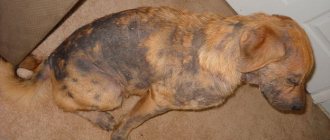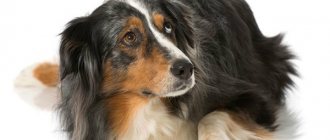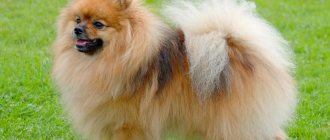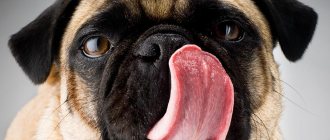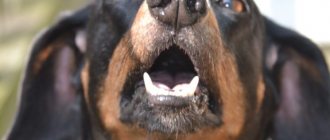Causes of coughing in a child
Among the most likely reasons are the following:
1. As a result of rhinitis, sinusitis or sinusitis, postnasal drip appears, in which nasal discharge flows onto the back surface of the pharynx. Because of this, irritation of the mucous membrane occurs, which causes a constant dry cough. In addition, vasoconstrictors and antihistamines can irritate the mucous membrane.
2. A common cause of coughing is heartburn, called gastroesophageal reflux. The contents of the stomach enter the oral cavity through the esophagus and irritate the mucous membrane of the larynx. A sore throat appears, which causes coughing without cold symptoms.
3. If a dry cough constantly haunts a child for a long time, then there is a high probability of allergic reactions. Moreover, measures aimed at treating colds do not give positive results. The allergy occurs suddenly; at the initial stage, the child has a cough and a stuffy nose. Active sneezing begins, and tears flow from the eyes. Later, the condition worsens, a serious disruption of the respiratory system occurs, although there are no inflammatory processes in the throat.
4. A mild cough may appear due to cardiovascular diseases, with the development of respiratory failure and pulmonary edema.
5. Enlarged lymph nodes compress the trachea or bronchi, causing constant coughing. At the same time, the respiratory organs themselves are in normal condition.
The main types and causes of cough in dogs
A Spitz's cough is a protective mechanism that clears the airways of pathogens, foreign bodies, pus, mucus and irritants. During a common cold, it helps the dog recover faster. But in serious diseases it is a symptom. Why the Spitz coughs and wheezes, and how to treat it, will become clear only after finding out the causes of the symptoms.
With a ball
Cough is one of the main signs of not only a cold. Depending on the character, it can indicate the development of completely etiologically different diseases. Observe your pet so that when visiting the veterinarian, you can accurately describe not only the duration, but also the severity, as well as associated clinical manifestations. This will help you prescribe treatment faster and more accurately.
Find out the different types of Spitz and their personalities.
The following characteristics of cough can be distinguished:
- Strength: mild, debilitating (may be accompanied by vomiting), strong hysterical.
- Character: wet (pus, mucus, sputum), dry.
- Timbre: dull, sonorous.
- Duration: acute (from several days to a month), chronic (more than one month, maybe years).
- Time of manifestation: morning, evening, all day, and also in spring, winter or all year round.
Together with a general examination and study of the animal’s behavior, the listed characteristics will help diagnose the disease that causes coughing.
The dog is sick
Aviary
This type of cough is also called kennel cough. It is a symptom of a viral pathology that affects the animal's respiratory tract. The following viruses are pathogenic organisms:
- parainfluenza;
- reovirus and herpes;
- mycoplasma, as well as bordetella bronchiseptic virus.
These pathogens enter the dog’s body directly through contact during walks, at training grounds, exhibition events, and also when living together. A pet can become infected with the kennel cough virus from dogs that are already sick or have recovered from the disease.
Sleepy puppy
Symptoms in an infected dog begin to appear 3-10 days after infection:
- weak appetite or complete refusal to eat;
- mild to moderate cough, accompanied by regurgitation of foamy mucus (the Spitz coughs as if he was choking);
- enlarged tonsils;
- nasal discharge;
- elevated temperature.
The duration of this disease depends on the strength of the animal's immunity, but usually ranges from 10 to 15 days.
Miniature Spitz are the smallest of all existing dogs.
It is important to give your pet’s body a chance to cope with the infection on its own and develop even greater immunity to it.
If the dog gets worse and the cough gets worse, it means the body cannot fight the disease on its own. In this case, contact your veterinarian immediately to avoid complications. The most severe complication that can develop due to the aviary virus is pneumonia.
Pet in arms
After examination, the veterinarian will prescribe medication with the following drugs:
- expectorants;
- antibiotics;
- immunomodulators;
- vitamins and other medications, depending on symptoms.
Pneumonia
This disease is caused by the penetration of various viruses, bacteria and pathogenic fungal microorganisms into the lungs of an animal. For pets with reduced immunity, a fungal infection poses a particular danger.
In the bed
Pneumonia is always accompanied by a wet cough and the following symptoms:
- labored breathing;
- cardiopalmus;
- general weakness;
- elevated temperature;
- nasal discharge;
- lack of appetite.
The most dangerous type of pneumonia is aspiration. Dogs' lungs become inflamed due to the ingestion of residual gastric acid regulation and vomit. The main cause of the disease is considered to be esophageal paralysis. If pneumonia is suspected and a wet cough is observed, only a specialist can prescribe exactly how to treat the dog. Therapy depends on the causes of the disease and the general condition of the pet.
Cordial
Acute heart failure may also be accompanied by a cough. The enlarged heart presses on the trachea, causing cardiac cough, the characteristics of which are:
- clunk;
- absence of sputum and other secretions;
- painful attacks;
- increased fatigue and shortness of breath.
The dog is resting
One of the causes of cardiac cough is dilated cardiomyopathy. It occurs most often in older male dogs. Impaired pumping function of the heart muscle causes failure. The disease is extremely difficult for dogs to tolerate, and it can only be cured in the early stages. With this disease, the Spitz grunts and wheezes.
Attention ! At the first suspicion of this disease, take the animal to the veterinarian for examination.
Parasitic
A cough may appear due to infection of the body with worms. Parasites settle in the stomach, intestines, circulatory system, liver, lungs, and also the heart. This symptom is a sign of gastrointestinal or cardiac helminthic infestation.
A newborn coughs in his sleep - is this dangerous for his health?
Often mothers notice that a baby’s cough, combined with wheezing and runny nose, occurs after feeding and during sleep. In a horizontal position of the head and neck, saliva, residual breast milk or formula accumulates in the oral cavity. That is, the reasons why a child coughs in his sleep may be natural phenomena.
It is difficult for a baby to swallow correctly, especially when lying on his back for a long time. Perhaps a baby's cough in sleep is due to teething. During this period, the baby produces copious amounts of saliva, irritating the throat and causing a cough.
With ARVI, the cough is dry for the first days, and after two days sputum production begins. It happens that a child chokes on saliva and coughs in his sleep, his breathing becomes difficult, and suffocation may occur. If a cold is accompanied by a runny nose and a wet cough, then mucus flows down the back wall of the throat and accumulates. The attacks become more intense. If there are dangerous symptoms in infants, you should immediately call an ambulance.
Parents, having learned why the child coughs when he sleeps, will be more attentive to the “sniffling” of the nose from snot and the appearance of wheezing in the newborn. An overly persistent, hacking cough should alert you. The fact is that the nasopharynx in babies is narrow and short, and the tonsils, which protect against infection, are underdeveloped. ARVI is separated from laryngitis and bronchitis by a matter of days.
Coughing in an infant
This phenomenon in an infant, as in older children, in 9 out of 10 cases is a symptom of an acute respiratory disease or viral infection.
But if a baby coughs no more than 20 times during the day, then it is probably physiological in nature. That is, it does not indicate the development of a certain disease, but is necessary for the baby to clear the airways of accumulated mucus. In this case, there is no need to treat the baby.
Insufficiently humid and overheated air in the children's room leads to drying of the mucous membranes and soreness in the baby. A mild cough is possible during teething.
But in addition to relatively harmless coughing in an infant, it can also be caused by more serious reasons.
Sometimes it is a concomitant symptom of quite severe diseases that require immediate treatment. Therefore, if such a phenomenon is detected in a baby, you should definitely contact a pediatrician or call an ambulance. Only an experienced specialist will be able to objectively assess the child’s condition and prescribe appropriate therapy.
Nervous coughing in children
The nature of nervous cough has not yet been fully studied. This type of coughing is considered a habit that is difficult to break. This cough is more of a psychological factor that manifests itself during difficulties in life situations. A nervous cough occurs when an atypical situation occurs, close to extreme. Such psychological stress activates the cough center and increases its sensitivity. Therefore, such situations should never be underestimated.
Medical examinations for nervous cough give normal results and do not reveal pathologies. Therapeutic measures using antitussives also do not lead to success. Nervous cough is not a disease, but a habit.
Just like in adults, nervous coughing in a child appears due to stress. And stress itself is often encountered during school. Children are easily vulnerable and emotional; this causes nervousness, which manifests itself in the form of a nervous cough when the muscles of the larynx begin to twitch. This type of cough disappears during sleep.
Types of shortness of breath
There are several types of pathological shortness of breath.
- Respiratory shortness of breath. It occurs due to defects in the respiratory tract, foreign body, pulmonary edema, pneumonia. Its causes may be injuries to the chest or trachea, pleurisy, or rib fractures.
- Cardiogenic dyspnea. It occurs as a result of heart pathologies, such as heart failure, endocarditis and others. Cardiogenic pulmonary edema may occur, which occurs due to stagnation of blood in the lungs.
- Dyspnea of central origin. The causes of this type of shortness of breath are traumatic brain injuries and hematomas.
The dog's cough seemed to be choking, caused by the presence of parasites
The presence of parasites in a pet's body is a real problem. We are talking about pests such as hookworms and toxocaras. The infection process occurs when a larva or parasite is ingested.
When swallowed, the parasite enters the lungs. While inside, the process of reproduction occurs, which causes the development of tracheobronchitis and other ailments.
There are the following cough symptoms that indicate the presence of parasites:
- when lying down, the pet may cough more strongly;
- sudden weight loss occurs;
- the dog gets tired quickly, and in general his appearance suffers changes for the worse;
- swallowing water or food is difficult for him or he may refuse them altogether;
- presence of photophobia or seizures. It appears if the parasite is cardiac.
Important! It is strongly not recommended to independently treat a persistent cough that is caused by the presence of parasites. The pet should be shown to a veterinarian, who will select appropriate therapy.
Dog at the doctor's appointment because of a cough
Sneezes and coughs
Sneezing and coughing attacks in dogs look frightening, as if the animal is choking, convulsively gasping for air, and jerking its head. For an unprepared owner, such a picture will cause horror and panic, but there is no need to worry. Most likely, the pet has caught a cold.
His only symptom may be occasional sneezing or frequent coughing. But sometimes the disease takes on a different form:
- Heat;
- Chills;
- Lack of appetite;
- Lethargy.
In this case, the owner can independently cope with the problem:
- With children's "Pinosol", drop 1-2 drops into each nostril 3 times a day.
- When crusts appear, hydrogen peroxide diluted with water is dripped (1-2 drops each).
- Cough is treated with Pertussin children's syrup (no more than 1-2 teaspoons per day), Glyceram or Mucaltin.
If the cold is caused by hypothermia, then you need to take care of the warmth of the room in which the pet is located. It is better to put the heating pad in the sunbed for a while. From now on, you need to dress your dog in protective warm overalls and boots. There should be no drafts or temperature changes in the house due to air conditioning.
What to do if your dog can't clear his throat?
If your pet coughs a little and there are no other signs of pathology or changes in behavior, you should not worry. It's worth watching him for a day. If additional signs appear, such as fever, weakness, apathy and shortness of breath, it is worth taking him to the clinic.
The veterinarian will conduct an examination, diagnose the disease and prescribe treatment. Do not ignore a serious situation and go to the pharmacy for medicine without a prescription. Such behavior can be fatal for your pet, because it is impossible to diagnose the disease yourself.
In case of an attack of suffocation, you should act as follows:
- The small dog needs to be turned upside down, shaken (almost like a blanket), and patted on the back.
- When a reverse sneezing attack occurs, your pet needs to swallow saliva or take a deep breath. It is important for the owner to help the dog by pinching its nostrils or stroking its throat.
- A large animal will need to be brought to a standing position, its rear end raised slightly and the sternum firmly patted. If possible, you can carry out manipulations as with a small dog.
- It is necessary to ensure that during an attack the pet does not choke on its own tongue.
- If your pet has a short muzzle, you should place a finger in the mouth and check the opening of the airways. Representatives of the breeds often have a long and soft palate. Because of this, the airways are blocked.
- Stopping breathing requires resuscitation. Closed heart massage and ventilation are performed.
Video: what to do if your dog coughs as if he’s choking and is trying to burp something?
Treatment
Cough is one of the symptoms of the disease, and not an independent pathology. Only after determining the cause of the negative manifestation can therapy begin.
Rules
Algorithm of action when a dog develops a cough:
- to measure the temperature;
- examine the oral cavity and mucous membranes for ulcers, wounds, and foreign objects;
- you should not squeeze your throat, trying to feel if the bone is stuck;
- It is useful to check your pet’s stool: it may be easy to identify tapeworms or roundworms in the stool;
- if the dog is bleeding from the mouth or foam appears, you need to urgently take the animal to the veterinary clinic: perhaps the dog has swallowed something poisonous or has become intoxicated from stale food;
- In case of severe weakness, lack of appetite, coughing, watery eyes, sneezing, it is important to give the dog an antihistamine (allergy tablet). If your pet has not previously had negative reactions to irritants, then you need to consult a veterinarian;
- if there is a sharp deterioration in health, you need to urgently take the animal to the clinic to take emergency measures;
- A visit to the veterinarian is mandatory in any case, even in the absence of severe signs of damage to the body. It is important to figure out what the cause of the problem is and get tested.
Medicines
All medications are selected by a veterinarian taking into account the disease identified based on the results of the examination and tests. You cannot give your animal medications on your own, even if the pet has a chronic pathology: the veterinarian should periodically check whether the effect of the medications prescribed earlier is weakening.
The main types of drugs for the treatment of pathologies that cause coughing in dogs:
- parasitic infections. Deworming agents: tablets, suspension, powders, compositions for internal and external use. General strengthening drugs, blood purification compositions (infusion solutions), vitamins, drugs that relieve signs of intoxication after the death of parasites;
- viral infections. Antiviral drugs, vitamin and mineral complexes, tablets for fever, inflammation and pain, compositions to strengthen the immune system;
- bacterial infections. Antibiotics, probiotics to restore intestinal microflora, immunomodulators, vitamins;
- inflammatory processes. Preparations of the NSAID group, compositions for strengthening immune defense;
- allergy. Antihistamines: for a weak reaction - 2 and 3 generations, for a severe immune response - fast-acting names of the 1st generation (Suprastin, Tavegil). A special veterinary drug Allervet for allergies in dogs.
What to do if your dog can't clear his throat
If the dog cannot clear its throat, then the best solution is to contact the veterinarian. But often the owner cannot deliver the pet to the clinic in a matter of minutes. Then the following measures should be taken:
- you need to try to remove the object or make your four-legged friend burp. To do this, you need to examine the animal’s mouth and, if the object is stuck nearby, try to remove it with your hand. If a thin bone is stuck, then removing it with your hand can cause even more harm to your pet, so it is recommended to pull it out with tweezers;
- if the dog is not so big, then you can try to feel the object in the larynx with your hand and push it up into the throat. If this can be done, the animal itself will be able to spit it out;
- An attack can be alleviated by simply shaking the dog, which will provoke regurgitation. To do this, you will need to lift a large animal on its hind legs and tap it a little on its chest so that the desire to vomit arises;
- A simple pat on the animal’s back can alleviate the condition. Water can also help him get rid of his cough.
The dog can undergo therapy at home
The dog could have choked
Animals love to take everything they see into their mouths. These will be small toys, sticks, grass, fish bones and other things. Sharp objects get stuck in the esophagus. An attack begins, even to the point of nausea. If the esophagus has been scratched, your pet will feel like there is something stuck in its throat. He will try to clear his throat. The discomfort will only go away when the mucous membrane is restored. In time - approximately 10 hours.
You can also choke on other objects, children's construction sets and small toys. An animal can either swallow or inhale a thing through its nose. For example, swallowed thread or tinsel will begin to irritate the mucous membrane, causing a cough. Things get into the esophagus, irritating it. Nerve endings begin to react to everything. The dog begins to cough, trying to get rid of the object. The dog needs to be given a crust of bread. Rough food will eliminate the disease by moving through the esophagus. If this does not help, then you need to contact your veterinarian.
Causes in puppies
Puppies are most susceptible to kennel cough. Therefore, at the first suspicious symptoms, rush to the clinic. Little Spitz dogs, like children, love to try everything, especially during their shift. Therefore, ingestion of small objects cannot be ruled out.
Some owners, after bathing their puppy, do not dry it properly. A small draft is enough for the baby to get bronchitis or pneumonia. These are quite dangerous diseases that will not go away without rational treatment.
How to treat
If you notice that your pet has begun to breathe heavily, sneeze and cough, do not leave things to chance, take action and contact a veterinarian.
A cold cough lasts only 2-3 days and goes away on its own. There is no need to treat it; it can harm the health of the animal.
Important! Do not mindlessly give “human” coughing and expectorant medications to a sick animal. Without knowing the dosage, you can cause an allergic reaction and other side effects.
It should be understood that coughing is only a symptom that can only be correctly interpreted after a complete examination of the dog.
Have your dog checked regularly by a veterinarian
If the animal coughs for 2-3 days, wait; if the condition worsens, go to the veterinary clinic immediately.
Causes
In order to determine why the dog began to choke, you need to pay attention to how the pet behaves in such situations. If the animal swallows air with sharp sighs, as if it cannot exhale, this condition is not dangerous. But sometimes this phenomenon can be a symptom of a disease or indicate disorders in the body.
When a dog begins to sneeze and choke, the owner's first reaction is fear and panic. This is a big mistake, because only confident and calm actions of the owner can help the dog come to its senses. What measures should be taken if the pet begins to choke?
- If your pet is having an attack of “reverse sneezing,” you need to lightly stroke the dog’s throat, pinch its nose and open its mouth slightly. This will help the pet increase the flow of air into the body. After the dog takes several deep exhalations and inhalations, the attack of “reverse sneezing” will stop.
- In the case when, despite the actions of the owner, the attack does not stop, you need to consult a doctor. Lack of proper breathing can be associated with various diseases, a foreign object entering the nasopharynx, a heart attack, or damage to the respiratory system. The faster your pet receives the necessary help, the greater the chance of an easy solution to the problem.
- If stress is the cause of the lack of air, the owner should calm the dog down, pet it, give it a treat, etc.
If your dog is panting frequently, you should immediately consult a doctor. Timely and high-quality treatment can save your pet's life!
When an owner sees his dog choking, it causes great concern. However, there are many reasons for this condition and it is not always life-threatening for the animal.
Most often, this is a non-threatening condition called “reverse sneezing.” It looks as if the dog is sucking in air through its nose with sharp sighs and as if it cannot exhale. She stands with her head bent, and it seems that the dog is suffocating.
There may even be a urge to vomit or even vomiting itself. The reasons for this condition are unknown to doctors. Such attacks begin suddenly and also pass, but they are not dangerous to the health of the animal. Another reason can be called dangerous - when a foreign object gets into the dog’s nasopharynx.
This attack is similar to a “reverse sneezing”, but it does not stop and threatens the dog with suffocation. A dog may also choke and grunt as a result of a heart attack. In this case, her tongue turns blue. Or fluid, air, or blood may accumulate in the animal's chest cavity.
Breathing may be difficult due to stress. For example, when a dog
afraid of fireworks or gunshots. Some breeds have such a nasopharynx structure that they often breathe very noisily, and also pant and grunt while jogging or playing.
Prevention
Any disease is easier to prevent than to cure. Therefore, keep an eye on your pet.
Treatment brings a lot of problems, not only physical, material, but also temporary. Some diseases can be treated within a month, while others cannot be completely cured until the end of the pet’s life.
Follow the general recommendations for the care and maintenance of your Spitz, and there will be no problems with its health.
Regular inspection
Regular periodic examination is mandatory for the presence of various signs that characterize the health of the pet:
Fluffy puppy
- mucous membranes;
- skin;
- wool;
- general activity and motor skills.
Important! If at least one of the indicators is abnormal, contact your veterinarian.
Visit to the veterinarian
Periodically take your baby to the veterinarian for examination. Preventive diagnostics should be regular so that the disease can be recognized at an early stage.
At the veterinary clinic
You should visit the veterinary hospital at least twice a year, and preferably once every season.

